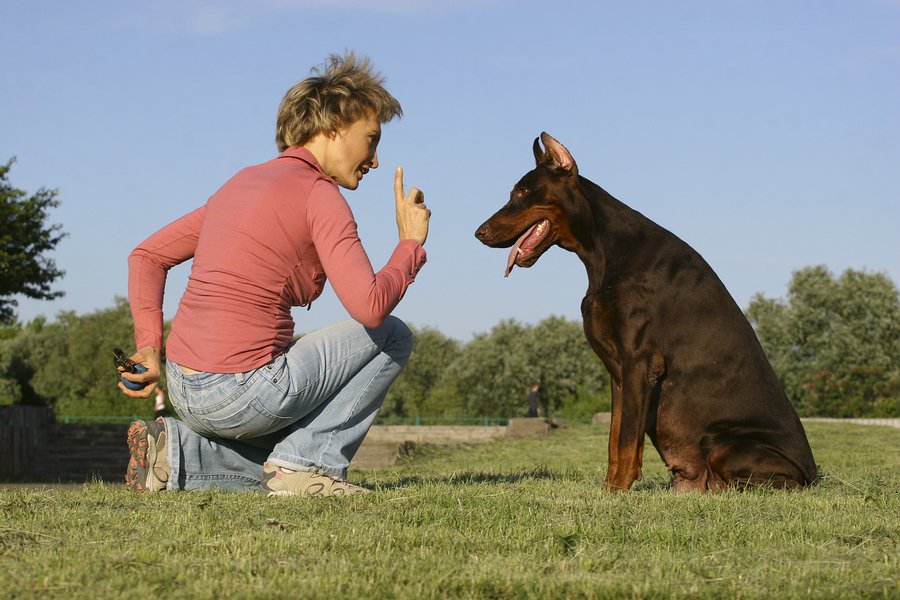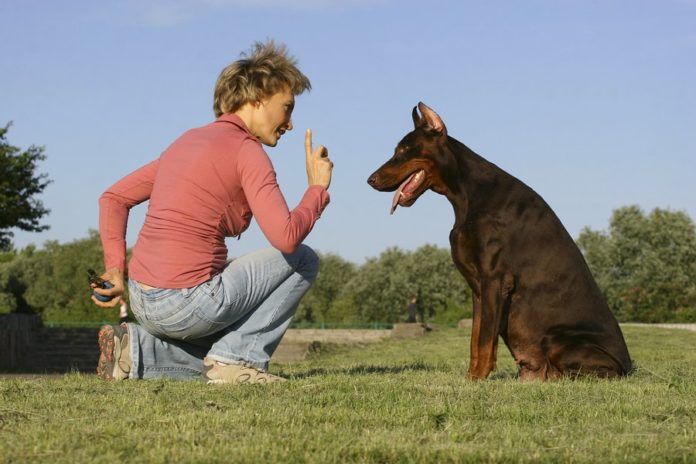© pavelshlykov | Bigstock

Let’s say your dog is aggressive to the point that you fear he will truly hurt someone. Or he won’t stop jumping on people, or barking, or otherwise engaging in behavior that many find obnoxious. Or you simply would like to enjoy a relationship with him in which he is able to respond to your cues to come, fetch, wait, or whatever but haven’t had much success training him on your own. Where do you turn?
It turns out there are a number of types of credentialing for animal behaviorists. Here’s a rundown so you can find the best match for your dog — and you.
© Yastremska | Bigstock

Board-Certified Veterinary Behaviorist. A veterinarian who is board-certified in animal behavior will have the letters DACVB behind his or her name, which means the doctor is a Diplomate of the American College of Veterinary Behaviorists — a designation recognized by the American Veterinary Medical Association. It’s not an easy status to attain. It means not only that the doctor graduated from an accredited four-year veterinary school but also that he or she has received additional training, generally at least three years, in veterinary behavior. The training must occur via an approved program and generally consists either of a behavior-oriented residency at a college of veterinary medicine or individual mentoring that meets specific criteria. A veterinary candidate for board certification in behavior must also author — and publish — a research project in veterinary behavior, have written case reports, and sit for a rigorous and comprehensive two-day examination.
Because veterinary behaviorists have been to medical school for dogs and other animals, they are uniquely knowledgeable about the complicated interplay between medical problems and behavioral issues. That’s why they are careful to rule out medical causes of behavioral issues before applying behavioral treatment. For instance, pain from an as-yet undiagnosed illness can make an otherwise docile dog aggressive, and diseases such as hyperthyroidism can alter a dog’s mood or affect.
Another plus is that because they are doctors, veterinary behaviorists can prescribe drugs such as antidepressants and anti-anxiety medications to take the edge off impulses that lead to problem behaviors, all while teaching owners behavioral tricks for readjusting their pets. Their familiarity with psychotropic medications extends to understanding their side effects and interactions with other medications.
To learn more about veterinary behaviorists, surf to dacvb.org, which has a directory of these professionals by state. Just click on “Find a Board Certified Veterinary Behaviorist” at the top right of the home page.
Certified Applied Animal Behaviorist. While all veterinary behaviorists have the same level of training — veterinary school followed by a residency in animal behavior — certified applied animal behaviorists may come through the ranks a bit differently from each other, although all of them are put through the paces to a significant degree. To start with, they must have an undergraduate and a graduate degree. And all must have passed rigorous oral and written exams, published articles in scientific journals, have had hands-on supervised experience with animals, and met the course work and experience requirements for certification set forth by the Animal Behavior Society (the leading organization in North America for the study of animal behavior). But they don’t have to be veterinarians (and if they’re not they can’t prescribe medications), although some are. Rather, they must have a master’s degree or a Ph.D. degree in a behavioral science with specific courses in animal learning and ethology (behavior). Alternatively, they can meet the criteria for certification by earning a DVM (doctor of veterinary medicine) with advanced training in animal behavior.
The home page of Certified Applied Animal Behaviorists makes it very clear that “your veterinarian is the first person you should contact when your pet exhibits problem behavior or your pet’s behavior changes. Changes in behavior or behavior problems can reflect underlying medical conditions, which must be evaluated by your veterinarian.”
Once medical conditions have been ruled out, behavioral solutions to a dog’s behavioral problems can be considered and implemented, says this group of professionals. To find a certified applied animal behaviorist in your area, go to corecaab.org and click on the “Behaviorist Directory” tab at the left.
International Association of Animal Behavior Consultants. Someone certified by the International Association of Animal Behavior Consultants is not at the doctoral level, but he or she has “gone through a rigorous training program that provides a good basis in behavior modification,” says the head of the Tufts Animal Behavior Clinic, Stephanie Borns-Weil, DVM. The association provides networking and educational opportunities for members through on-line discussion groups, videos and conferences, as well as educational courses and mentorships. It offer four tiers of membership to match different skill levels.
Members work to minimize the use of aversive stimuli (infliction of punishment) and maximize the effective use of reinforcers (positive rewards) to modify animal behavior. Positive reinforcement should be the first line of teaching, the organization says, because it “is associated with the lowest incidence of aggression, attention-seeking, and avoidance/fear in learners.” Members agree to adhere to the LIMA (least intrusive, minimally aversive) approach and a well-established Code of Ethics upon joining.
To find someone certified by the International Association of Animal Behavior Consultants within 50 miles of your home, go to iaabc.org and type in your zip code after clicking the “Find a Consultant” tab at the top.
Karen Pryor Academy for Animal Training & Behavior. Someone who is Karen Pryor Academy (KPA)-certified has learned force-free training from a community of positive reinforcement trainers who see shared value in collaboration and discussion of training science, practices, and related issues.
This organization currently offers nine courses in animal training. Courses feature curricula frequently developed in collaboration with leaders in the field. These same collaborators also facilitate, coach, or teach the course material.
Students enroll and participate in all of the programs via an online learning platform, which has its limitations. That said, many of the courses include online facilitated coaching. And the Dog Trainer Professional course (which is why you’re reading this, after all) does have a hands-on workshop component. Says the organization’s website, “we believe that great teachers possess both a solid knowledge of the science that governs learning, and honed practical abilities in both training animals and teaching other people to train animals.”
To find a Karen Pryor Academy-certified trainer/behaviorist in your area, go to karenpryoracademy.com and click on “Find a Great Dog Trainer.” You can search within as few as five, 10, 15, or 25 miles from your zip code or as many as 50, 100, 300, or even 3,000.
Certified Professional Dog Trainer. The Certification Counsel for Professional Dog Trainers offers both Dog Trainer Certification and Behavior Consultant Certification. Neither certification requires specific schooling to qualify. Rather, to become a certified professional dog trainer, you must take and pass a multiple choice exam. There are two levels. For the first level, which is specifically about knowledge, the multiple choice test is all that is necessary. For the next level, you must demonstrate through a video the practical skills necessary to train dogs and teach others to train their dogs.
Of course, training is largely about “sit,” “stay” and so on. For separate certification as a “behavior consultant,” a different multiple choice exam is required. It covers applied behavior analysis; consulting skills and best practices; ethology, body language, and observational skills; health, development, and life stages; biology and anatomy; and scientific method.
Clearly, the bar is not set nearly as high for a certified professional dog trainer or certified behavior consultant as for a veterinary behaviorist or certified applied animal behaviorist. It also is not clear from the website what approach behaviorists are taught to help a dog get past problematic behavior, which makes choosing a certified applied animal behaviorist more hit-and-miss. That does not mean it is impossible for one of these people to help you help a dog who has a behavior problem. But there’s no way around it: choosing someone with this level of certification comes with more of an element of uncertainty as far as their knowledge and skill set. You’ll want to do some digging.
When making a choice
If you’re considering bringing your dog to a professional for help with a behavior problem, things have probably gotten pretty serious. Most often, dogs see animal behaviorists because of aggression issues that can’t be kept under control; the dog is dangerous to other dogs or to people, and the owner doesn’t know how to stem the aggressive inclination.
Much of the choice is going to be based not just on the level of education of the person you seek out but also on cost and convenience — the price of the visits and the drive time to the sessions. Fair enough. But no matter who you choose, it is critical that you engage someone who uses positive tactics only. More than a century ago, psychologist Edward Thorndike proved that you could teach a dog (and other species) a lot more by rewarding the right response than by punishing the wrong one. Positive reinforcement works more quickly and effectively over the long term.
Unfortunately, many dog owners who bring their charges to our own Animal Behavior Clinic to help correct behavior problems have, in a well-intentioned but misguided move, already put their pets through hard-knocks training in various classes — training that uses choke or prong collars or other devices invented to inflict pain. They feel bad about it but went against their instinct to treat their dog kindly in the mistaken belief that it was the right thing to do.
Don’t go against your instinct. If a behaviorist does not want to get your dog over the behavioral hump kindly and respectfully, put a basket muzzle on your pet in dicey situations that could trigger unacceptable behavior and take the time to choose a different behaviorist.
None of this means that a dog with a behavioral problem doesn’t need firmness. But firm is not punishing, and inflictions of physical pain are not simply “corrections,” as they are sometimes euphemistically called. They are abuse.





